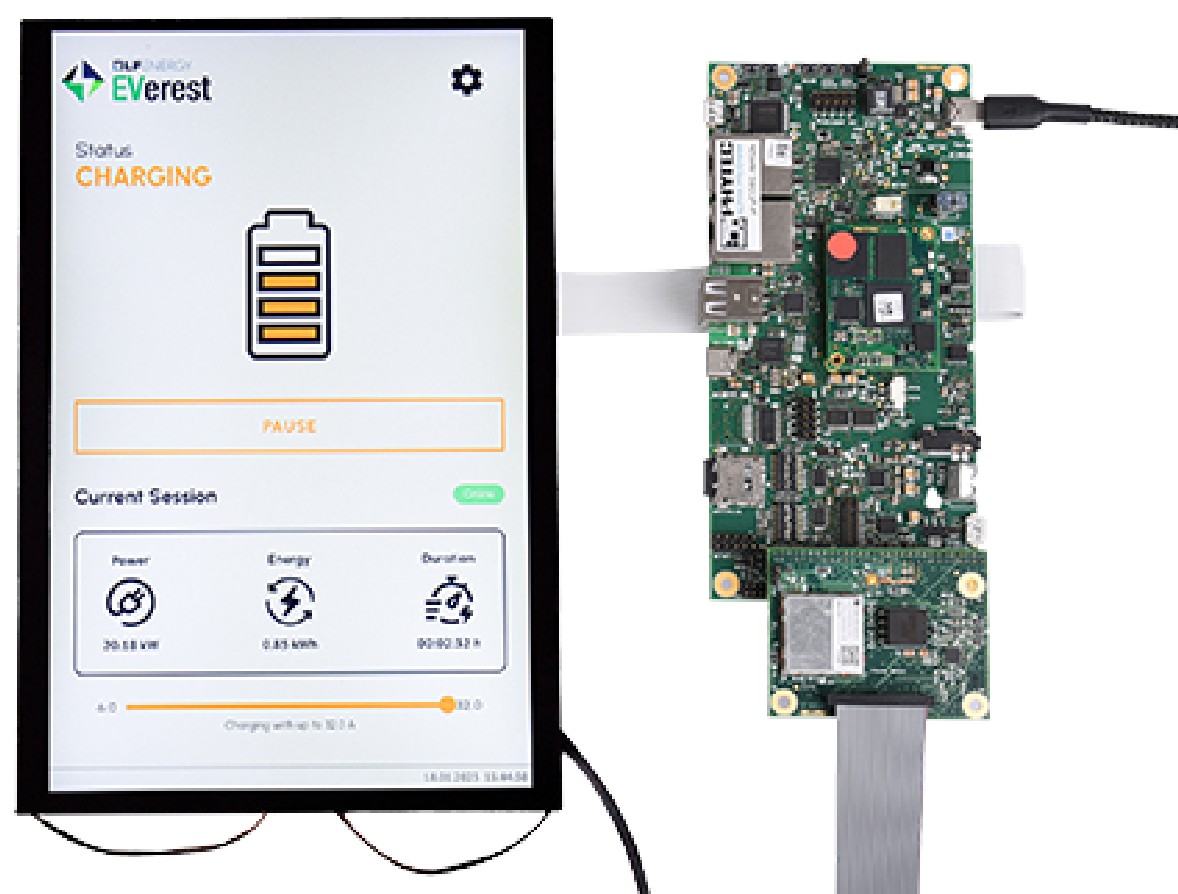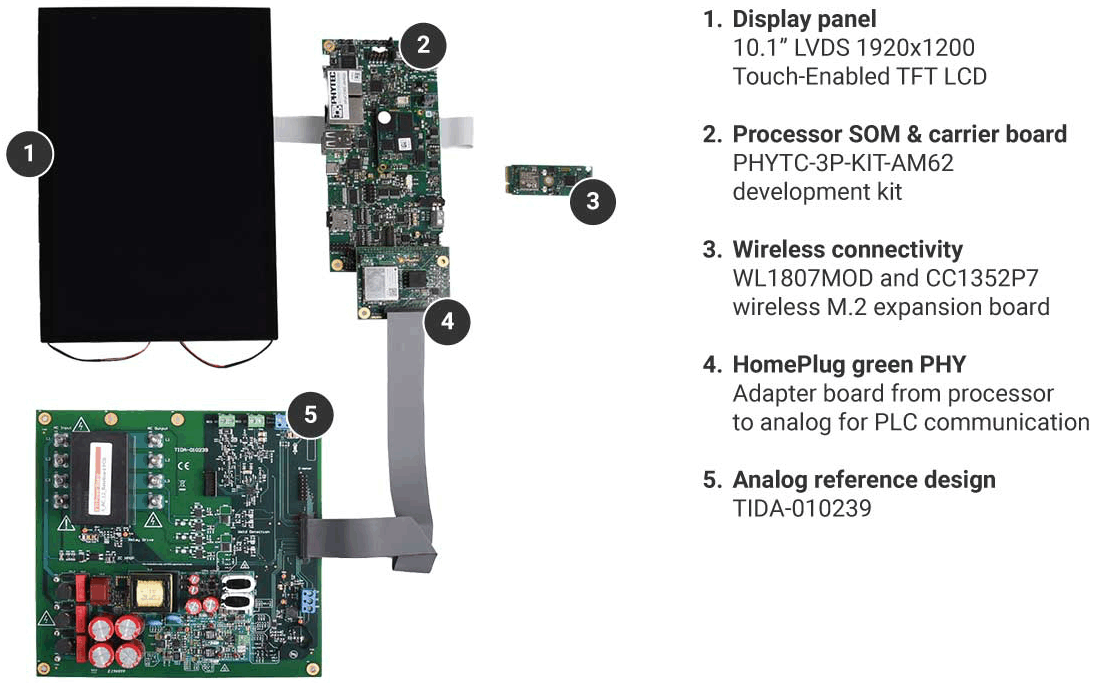-
Smart, Connected AC Level 2 EV Charging Station Based on AM625 with HMI
Smart, Connected AC Level 2 EV Charging Station Based on AM625 with HMI
 Figure 1 EV Charging Station HMI
Subsystem
Figure 1 EV Charging Station HMI
SubsystemWhat is it?
The EVSE development platform for AM62x is a commercial L2 charging station with curated hardware and software to help hardware designers and software developers go to production faster. A commercial implementation of an AC level 2 EVSE, or electric vehicle supply equipment, is the highest level of complexity before the introduction of DC fast-charging. This platform can easily be scaled down to an AC L2 residential system - without an LCD screen or multistation communication - and scaled down further to AC L1 residential system - single-phase only with lower voltages, 120-VAC in the US and 230-VAC in the EU.
Why is it needed?
AC L2 commercial EV charging stations are complex systems that require high power analog design, safety features, noise-immune analog handshakes plus digital communication, network connectivity, and display for human machine interface (HMI). The application-specific software required for ISO-15118 communication, which enables features such as Plug & Charge and vehicle-to-grid (V2G) bidirectional power transfer, is often different from the software for making a professional display serving up targeted ads on an LCD. Many engineering teams have expertise in one or more of these areas, but not all of them.
The development platform presents different combinations of hardware and software offerings, from TI and partners, to take a product to market faster. The system built around SK-AM62 is a better starting point for a team with digital hardware design experience that is cost-sensitive. Open-source software from PIONIX, built for the AM62x processor family, allows a team with software expertise to start customizing and integrating other embedded Linux components quickly. Engineering teams that specialize in analog power design can use the PHYTEC phyCORE-AM62 system-on-module and PIONIX software as-is to deploy a smart EV charging station in a fraction of the time, without purchasing expensive, off-the-shelf subsystems: panel PC for HMI, communications module for low-level communication to the EV, plus interconnects and custom software stacks.
How to get started?
Add all the required hardware sold from the TI store to your cart and purchase any required hardware needed from recommended external vendors. Determine if any optional hardware is required for your specific application, and purchased accordingly. While waiting for the hardware to arrive, read the online quick-start guides and download all required software. To learn more about this development platform, before or after making a purchase, click the links in Table 2. These are links to videos, white papers, and application notes related to the development platform or key components.
 Figure 2 Full AC Level 2 EVSE
System
Figure 2 Full AC Level 2 EVSE
System| Number | TI Part Number | Manufacturing Part Number | Manufacturer | Description |
|---|---|---|---|---|
| 1 | LTS-3P-LCDK | LCDK185 | Lincoln Technology Solutions | The LCDK185 is a display kit for the LCD185, a 10.1" LCD panel with touchscreen. The display comes with an adapter PCB for LED backlight power, interfacing directly with the PHYTC-3P-KIT-AM62 using a 40-pin FFC ribbon cable for transmitting LVDS signals. |
| 2 | PHYTC-3P-KIT-AM62 | phyBOARD-AM62x Development Kit (KPB-07124) | PHYTEC | The phyBOARD-AM62x Development Kit is a combination of the phyCORE-AM62x system on module (PCL-071) and the phyBOARD-AM62x-Lyra Carrier Board (PBA-C-24), which is a development kit for evaluating the SOM with any number of applications and getting started with software development. The expansion boards used in the Development Platform are required to add wireless communications via the M.2 socket and to interface between the AM62x processor and the TIDA-010239 with an application-specific PLC PHY. |
| 3 | M2-CC3301,LP-CC1352P7 | — | TI | The non-standard M.2 card is a size-optimized prototype designed to combine the functionality of WL1807MOD and CC1352P7 into a single board, using SDIO to communicate with the WiFi module and UART to communicate with the CC1352P7 device. This M.2 card is not in production. CC3301 replaces WL1807MOD to enable WiFi6. |
| 4 | SPRR489 | PEB-X-003 | — | This application-specific PHYTEC Expansion Board (PEB) is required to communicate with the EV. Commonly referred to as a PLC PHY, or HomePlug Green PHY, the PEB is an IC or module that is required for ISO 15118 digital communication between the EVSE and a vehicle. The PEB-X-003 is not in production. |
| 5 | TIDA-010239 | TIDA-010239 | TI | AC level 2 charger platform reference design - analog power reference design, connected to PEB-X-003 by a 40-pin Samtec® cable. FFSD-20-D-10.00-01-N is a 10-inch long variant of the cable. |
| Content Type | Title | Estimated Time |
|---|---|---|
| Video: Application overview | Smart, connected EV charging station development platform | 3 minutes |
| Quick Start Guide | EVSE development platform quick start guide | 30 minutes |
| Design Guide | AC Level 2 Charger Platform Reference Design (TIDA-010239) | 1 hour |
Technical References
- International Electrotechnical Commission, Electric vehicle conductive charging system - Part 1: General requirements, journal publication.
- International Electrotechnical Commission, Road vehicles — Vehicle-to-Grid Communication Interface — Part 2: Network and application protocol requirements, journal publication.
- International Electrotechnical Commission, Road vehicles — Vehicle to grid communication interface — Part 20: 2nd generation network layer and application layer requirements, journal publication.
- Pionix GmbH, EVerest documentation, "What is EVerest?", webpage.